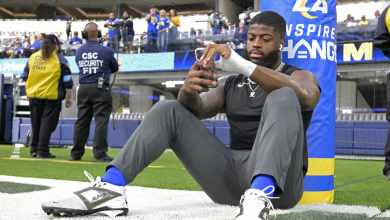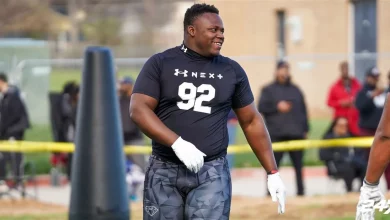Ohio State football is providing a blueprint for running back success — and outsiders like it

Ohio State University’s football program has long been a powerhouse in college football, renowned for its legacy, talent development, and consistent production of high-level players. The Buckeyes have sent an incredible number of athletes to the NFL, particularly in the skill positions, where running backs have long been a focal point. In recent years, Ohio State has evolved its approach to developing running backs, creating a blueprint that not only allows players to flourish within the collegiate system but also ensures they are well-prepared for success at the professional level. This blueprint has caught the attention of outsiders, including analysts, coaches, and scouts, who are now looking to Ohio State as a model for running back development.
From iconic figures like Archie Griffin and Eddie George to the more recent success stories of Ezekiel Elliott and J.K. Dobbins, Ohio State’s running back room has consistently produced top-tier talent. Yet, it is not just the sheer talent of individual players that makes Ohio State’s system unique; it’s how the program has refined its coaching methods, offensive schemes, and overall player development that has set it apart. This strategic combination of factors has enabled Ohio State to remain a dominant force in college football, and as a result, its approach to running back development is attracting significant attention from across the country.
In this article, we will explore how Ohio State has created a system that allows running backs to thrive, why it is being hailed as a blueprint for success, and how this model is influencing both college football and the NFL.
The Rise of Ohio State’s Running Back Legacy
Ohio State’s history of producing elite running backs dates back decades, with many of its former players achieving greatness at the professional level. The program has produced numerous Heisman Trophy winners and All-American selections, which speaks volumes about its ability to identify and develop elite talent. Players like Eddie George, who won the Heisman in 1995, and Ezekiel Elliott, who has become one of the NFL’s top backs, serve as bookends for Ohio State’s rich tradition in the running back position.
However, the true evolution of Ohio State’s running back program in recent years can be traced back to the rise of head coach Urban Meyer and the transformation of the offense under his leadership. Meyer’s spread offense, which placed a premium on pace, versatility, and the ability to stretch the field horizontally and vertically, maximized the running back’s potential. Under Meyer, Ohio State began to incorporate a more balanced offensive scheme, blending a potent passing attack with a dynamic rushing game. This allowed running backs not only to shine as traditional ball carriers but also as playmakers in space.
The arrival of Ryan Day as head coach in 2019 continued this offensive evolution. Day, known for his expertise in quarterbacks and offensive strategy, has taken Ohio State’s offensive identity to another level. With a focus on multi-dimensionality, Day has been able to adapt the Buckeyes’ offensive system to highlight the strengths of their running backs in new ways. Under his leadership, Ohio State has developed a reputation for producing NFL-caliber backs who excel in all facets of the game: running, blocking, receiving, and the mental aspects of the position.
A Multi-Dimensional Approach: How Ohio State Does It
What truly sets Ohio State apart when it comes to running back development is the comprehensive approach to training, scheme design, and player utilization. While other programs may focus primarily on one or two aspects of the position, Ohio State has created a system where running backs are developed into complete players who are capable of excelling at every part of the game. This holistic approach to running back development is why the Buckeyes have managed to produce so many successful players at the position.
1. Scheme Versatility:
The first key to Ohio State’s success with running backs is its ability to design offensive schemes that emphasize versatility. Ryan Day and his coaching staff have successfully adapted the Buckeyes’ offense to leverage the full spectrum of a running back’s abilities. This means Ohio State’s backs aren’t limited to traditional between-the-tackles running. Instead, they are tasked with becoming multifaceted playmakers capable of lining up in multiple formations and being used in various ways.
Whether it’s running between the tackles, bouncing outside, or catching passes out of the backfield, Ohio State’s offensive system is designed to maximize the talents of its running backs. In Day’s offense, running backs are frequently put in positions where they can exploit mismatches against defenders. For example, utilizing running backs as pass-catching threats in space allows them to create big plays in the open field, taking advantage of the defense’s attention on the wide receivers and quarterbacks.
Ezekiel Elliott’s 2014 season, which helped propel Ohio State to a national championship, was a prime example of how Day’s offensive principles were in play even before he became head coach. Elliott demonstrated his ability to be a complete back, running with power, speed, and vision while also becoming a key factor in the passing game. His versatility made him a weapon that defensive coordinators struggled to contain, and that blueprint has remained consistent with Ohio State’s more recent backs.
2. Focus on Strength and Conditioning:
Ohio State’s strength and conditioning program is another key pillar in its blueprint for running back success. The program, run by Ohio State’s expert staff, has consistently produced some of the most physically dominant players in college football. Running backs at Ohio State are not only taught the skills necessary to succeed on the field but are also developed to withstand the physical rigors of high-level competition.
Ohio State’s focus on building a balanced body—one that is strong, explosive, and durable—helps ensure that running backs can maintain their effectiveness throughout an entire season. The strength program includes training that emphasizes lower body power, core stability, and overall conditioning. This training helps backs develop the endurance to break tackles, the explosiveness to accelerate through the line of scrimmage, and the strength to power through contact.
In addition to this, Ohio State also emphasizes injury prevention, ensuring that running backs are ready to endure the long physical grind of a season. The program’s emphasis on flexibility, mobility, and proper technique further reduces the risk of injury, which is a critical factor in ensuring longevity at the college and professional levels.
3. A Pro-Style Mindset:
Perhaps the most important aspect of Ohio State’s running back development system is its ability to prepare players for the NFL. The program is designed with a pro-style mindset that prioritizes the skills that will make running backs successful at the next level. From pass protection to blocking schemes to route running, Ohio State ensures its backs are ready to take on the full range of responsibilities required in the NFL.
The emphasis on pass protection is one of the most notable aspects of Ohio State’s development of running backs. In the modern NFL, running backs who can protect the quarterback in the passing game are in high demand, and Ohio State’s program teaches its players how to pick up blitzes and engage with linebackers and defensive linemen in a way that helps keep quarterbacks safe. This aspect of development ensures that Ohio State’s backs are ready to make an impact in all facets of the game.
Additionally, the Buckeyes’ emphasis on catching passes out of the backfield helps their players stand out in the NFL draft. In today’s NFL, running backs who can contribute as both runners and receivers are more valuable than ever, and Ohio State’s system prepares backs to excel in both roles.
4. The Leadership and Mentorship Factor:
Ohio State also emphasizes leadership development within its program. Running backs aren’t just taught to be great players—they’re taught to be great leaders. Whether it’s in the locker room, during practice, or on game day, the Buckeyes’ running backs are expected to set an example for their teammates. This leadership mentality is vital, as it instills a sense of responsibility, maturity, and accountability in the players.
For example, in recent years, players like J.K. Dobbins and Trey Sermon have stepped into leadership roles both on and off the field, mentoring younger backs and helping to raise the program’s overall standard of excellence. This leadership-driven culture has created a tight-knit, motivated group that consistently pushes each other to improve, fostering an environment where every running back has the opportunity to thrive.
The Outsider Perspective: Why Others Are Looking to Ohio State’s Blueprint
Ohio State’s approach to developing running backs has caught the attention of coaches, analysts, and teams across the country—and not just in the Big Ten. College programs across the nation are beginning to study the Buckeyes’ methods, while NFL teams have taken notice of how Ohio State’s backs transition so smoothly from college to the pros.
1. NFL Success:
As Ohio State continues to churn out NFL-caliber running backs, the program’s success is becoming a model for other schools. The transition of players like Ezekiel Elliott, J.K. Dobbins, and Trey Sermon to the NFL has reinforced the program’s reputation as one of the best places for running backs to develop. The success of these players at the professional level has made it clear that Ohio State’s system is producing players who are prepared to thrive at the highest level of football.
NFL teams are increasingly looking for backs who are versatile, durable, and capable of contributing in both the running and passing games. Ohio State’s emphasis on these traits makes it an attractive blueprint for other programs looking to develop similar players. Additionally, NFL teams value players who are prepared for the physical demands of the league, which Ohio State’s development system emphasizes through strength training and injury prevention programs.
2. College Programs:
College programs around the country are also beginning to adopt some of the principles of Ohio State’s running back development model. Programs like Alabama, Georgia, and Clemson, who also boast high-powered offenses, have taken note of the Buckeyes’ ability to develop well-rounded running backs who can contribute in every area of the game. These programs are now emphasizing
multi-dimensionality in their running backs, ensuring that they have the skills needed to excel in both the rushing and passing attacks.
A Blueprint for the Future
Ohio State’s system for developing running backs has set a new standard in college football, and the program’s approach is influencing not only other college programs but also NFL teams. The combination of offensive versatility, strength conditioning, pro-style preparation, and leadership development has created a model for success that is helping to produce some of the most talented and well-rounded running backs in the country.
As more and more programs look to Ohio State as a blueprint, it’s clear that the Buckeyes’ success with running backs is no fluke. It’s the result of a carefully crafted system designed to prepare players for success at the highest levels of the sport. As long as Ohio State continues to refine this blueprint, its running backs will remain among the best in the country—and the NFL will keep benefiting from the fruits of this development system.









